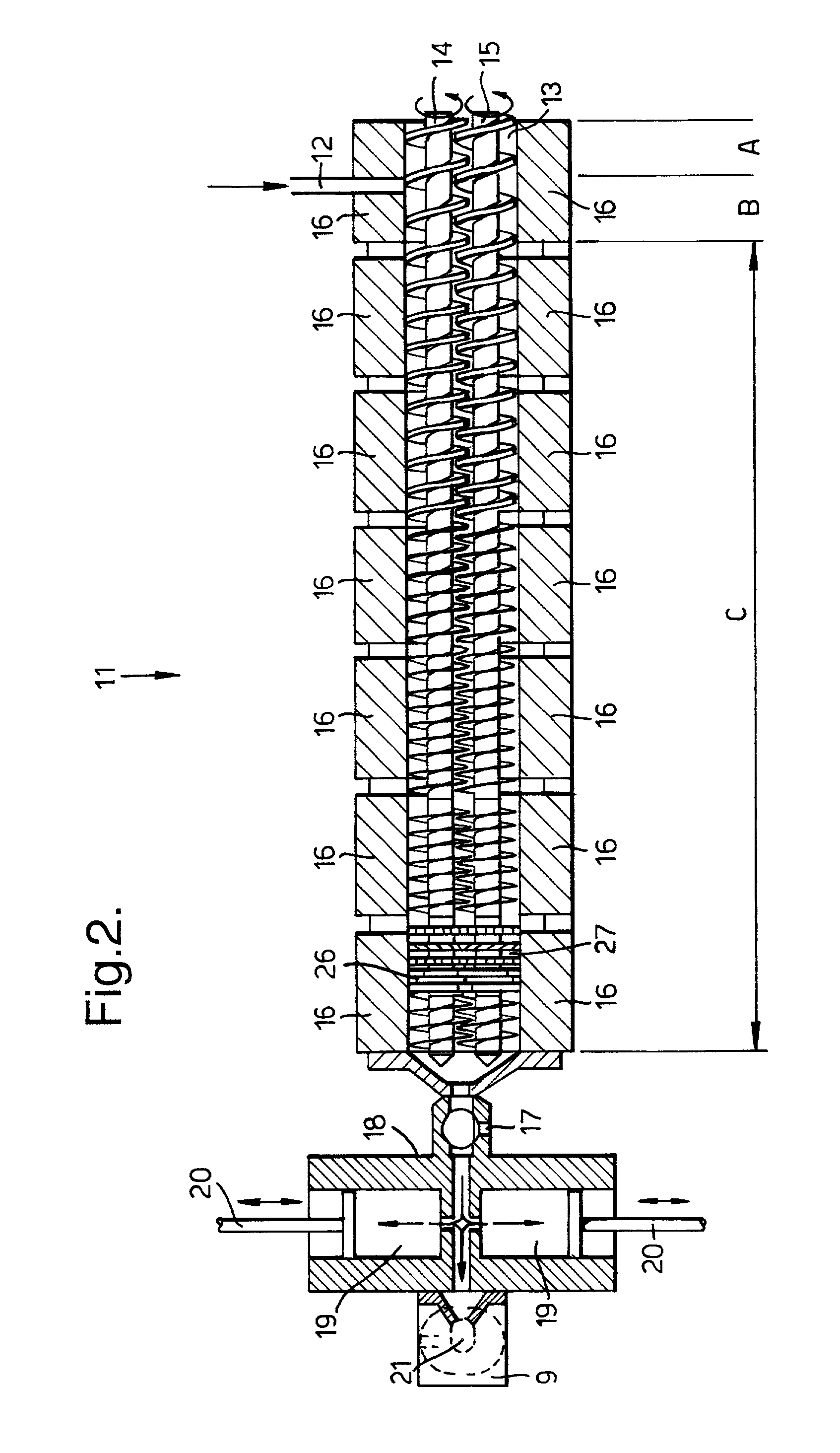Process and apparatus for the production of a detergent composition
a technology of detergent composition and process, which is applied in the direction of combs, buttons, other domestic objects, etc., can solve the problems of poor or even non-release of bars from the die surface, visible imperfections on the bar surface, and residual detergent on the die halves, so as to achieve low operating temperature and economic operation
- Summary
- Abstract
- Description
- Claims
- Application Information
AI Technical Summary
Benefits of technology
Problems solved by technology
Method used
Image
Examples
example 1
[0262] A reciprocating screw injection moulding unit according to FIG. 1 sold as the "SANDRETTO Series 7 HP135" having three temperature controlled zones was used. The machine was fitted with a 50 mm diameter dough moulding compound screw and barrel. The feed means comprised a conventional stuffing pot, or manual feed as appropriate to the material. A screw rotation rate of 80 to 100 rpm was used.
[0263] The mould (9) comprised a pair of aluminium mould parts defining a bar shape. These were as those conventionally used in die stamping of detergent bars, modified by the addition of a feed hole sized to take the nozzle, and small holes at appropriate places in the mould to allow air to vent during filling.
[0264] Detergent formulations A, B and C were injection moulded.
1 Formulation A was as follows: wt % active Directly Esterified Fatty Isethionate 27.00 Palmitic / stearic acid blend 17. 00 Coca amido propyl betaine 5.00 Maltodextrin 10.00 Sodium Stearate 6.00 PEG 8000 21.62 PEG 300 2.0...
example 2
[0268] An apparatus according to FIG. 2 comprising a BETOL co-rotating twin screw extruder with 40 mm diameter screws and eight temperature control zones was used. The temperatures of the connection valve 17 and the injection head assembly (18,19,20) was also controlled.
[0269] A novel piston type injection unit according to the present invention was fitted at the end of the screw extruder. Detergent compositions as set out below were prepared in molten form and fed to the extruder using a Bran and Luebbe metering pump. The molten feed was at a temperature of 90 to 95.degree. C. It was maintained in a stirred, heated feed pot.
[0270] During filling the mould was moved either manually, or hydraulically using a mould moving mechanism according to FIG. 4 of the present application.
[0271] Detergent formulations D and E were injection moulded.
2 wt % active Formulation D was as follows: Directly Esterified Fatty Isethionate 38.0 Propylene glycol 21.5 Sodium Stearate 12.2 Sodium Palmitate 12...
example 3
[0274] An apparatus comprising a BETOL co-rotating twin-screw extruder with 40 mm diameter screws, eight temperature controlled zones, and a low shear, in-line injection head was used as depicted in FIG. 3. Detergent composition E was prepared in molten form (95.degree. C.) and held in a stirred, heated feed pot. It was then fed into Zone E of the extruder using a Bran & Luebbe metering pump. Detergent composition B was fed at ambient temperature to zone D as 4 mm diameter noodles using a Ktron feeder. The maximum injection pressure and the holding time were recorded. The results are given in Table 3.
[0275] The detergent compositions were in a semi-solid state when they entered the mould. In all the runs, the mould was at ambient temperature before fill and cooling was effected by packing solid CO.sub.2 around the outside of the mould for the period of time specified plus maintaining the mould at ambient temperature for a further 5 minutes.
[0276] These runs illustrate that the surfa...
PUM
| Property | Measurement | Unit |
|---|---|---|
| temperature | aaaaa | aaaaa |
| pressure | aaaaa | aaaaa |
| temperature | aaaaa | aaaaa |
Abstract
Description
Claims
Application Information
 Login to View More
Login to View More - R&D
- Intellectual Property
- Life Sciences
- Materials
- Tech Scout
- Unparalleled Data Quality
- Higher Quality Content
- 60% Fewer Hallucinations
Browse by: Latest US Patents, China's latest patents, Technical Efficacy Thesaurus, Application Domain, Technology Topic, Popular Technical Reports.
© 2025 PatSnap. All rights reserved.Legal|Privacy policy|Modern Slavery Act Transparency Statement|Sitemap|About US| Contact US: help@patsnap.com



